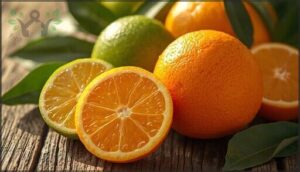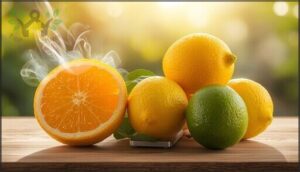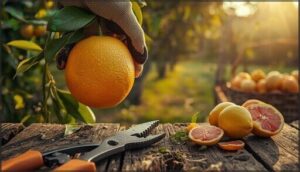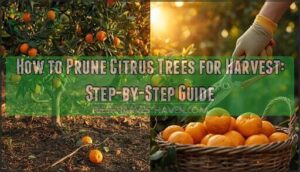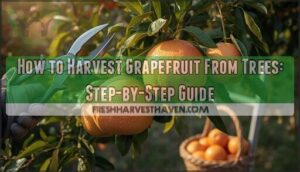This site is supported by our readers. We may earn a commission, at no cost to you, if you purchase through links.
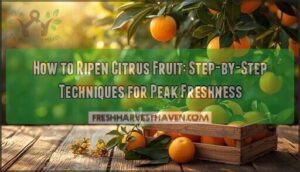
Most citrus fruit won’t ripen further once you pick it from the tree. Unlike bananas or avocados that continue developing sweetness after harvest, oranges, lemons, and grapefruits reach their peak flavor while still attached to branches. This means timing your harvest correctly makes all the difference between tart disappointment and juicy delight.
You can, however, improve the appearance and texture of citrus through careful storage and handling techniques. Understanding citrus fruit ripening techniques helps you recognize when fruit is truly ready, select the right harvesting methods, and maintain quality after you bring it indoors. These practices guarantee you get the best flavor, longest shelf life, and minimal waste from every piece of fruit.
Table Of Contents
Key Takeaways
- Citrus fruit won’t ripen or develop sweetness after you pick it from the tree, so harvest timing is the only chance to capture peak flavor—unlike bananas or avocados that continue ripening off the plant.
- You’ll get the best results by harvesting when sugar levels hit 12–18 °Brix and using sharp hand clippers to prevent bruising, which can reduce fruit damage by over 30% compared to generic tools.
- Proper storage at 1–4°C with 85–90% humidity can extend citrus shelf life by 6–8 weeks, while ethylene exposure and techniques like wax coating or 1-MCP treatment help preserve freshness even longer.
- Different citrus varieties follow their own maturity patterns—oranges rely on sugar content and color shifts, grapefruits show dramatic sweetness changes in the final month, and lemons depend on sugar levels rather than color cues.
Key Factors Affecting Citrus Ripening
Citrus fruit ripening isn’t just about waiting for color to change. A mix of factors behind the scenes shapes how sweet and juicy your fruit becomes. Let’s take a closer look at what really matters.
Temperature and Humidity Influence
In your quest for peak citrus flavor, mastering temperature and humidity matters most. Ideal conditions—20–25°C and 85–90% humidity—safeguard freshness, keeping rind shriveling at bay. Watch for temperature fluctuations; these disrupt consistent coloring and shorten shelf life. High heat, especially above 30°C, can spike respiration rates, resulting in faster ripening and a noticeable loss of juiciness.
Considering the broader context, climate change impacts can affect agricultural practices and fruit yields.
Ethylene Gas and Light Exposure
After managing temperature and humidity, think about ethylene gas and light wavelengths. Even a low ethylene concentration—just 1–10 ppm—can nudge your citrus toward ripeness, especially at room temperature or in a warm environment.
Light, particularly blue and red, works in tandem with humidity interaction. Still, not every cultivar responds the same, so pinpointing your fruit’s sensitivity pays off.
Citrus Variety and Environmental Conditions
The way your citrus fruit ripens depends as much on the variety you’re growing as the world around it. Variety ripening times aren’t set in stone; climate impact, soil quality, and nutrient availability all shape the results.
Sunlight and local humidity drive both pigment and sugar development. Some citrus fruit varieties rush toward sweetness, while others take their time, responding to shifting environmental influences on fruit.
Understanding the impact of environmental factors, such as those related to systematic review, can help in optimizing the conditions for citrus fruit ripening.
Identifying Ripe Citrus Fruit
Knowing exactly when your citrus fruit is ripe can make all the difference in taste and texture. There are a few key things you can look for to pick the best ones.
Here’s what to check as you size up your harvest.
Physical Signs of Ripeness
Think of a citrus fruit’s peel color as its mood ring—shifting from green to vivid yellow-orange when maturity hits. As ripeness develops, fruit firmness drops slightly, the rind aroma gets more pronounced, and juice sacs deepen in color.
You might also notice seed maturity picking up and peel texture thinning as these cues work together to reveal harvest readiness.
Taste, Aroma, and Weight Indicators
Let your senses lead the way—true ripeness in citrus is all about taste, aroma, and weight. Bite into the fruit: peak sweetness levels and bold flavor intensity should jump out.
True ripeness in citrus reveals itself through taste, aroma, and weight—peak sweetness and bold flavor should jump out when you bite in
You’ll notice a fragrant smell signaling freshness. For juiciness, pick up the fruit—a heavier feel points to more juice inside, marking the best juiciness indicator around.
Species-Specific Maturity Patterns
Different citrus fruits follow their own ripening roadmap, and understanding species-specific patterns helps you nail the harvest window every time.
- Orange maturity peaks when soluble solids hit 10–12.5 °Brix, with color shifts guiding your timing
- Grapefruit ripening brings dramatic color changes and sweetness jumps in the final month
- Lemon ripeness and lime cultivars rely on sugar levels, not color cues
- Varietal interactions with climate can shift harvest dates by one to two weeks
Best Harvesting Techniques for Citrus
Getting citrus off the tree might seem straightforward, but the wrong approach can damage both your fruit and next year’s crop. You’ll want to use techniques that protect the delicate skin and keep your tree healthy for seasons to come.
Here’s how to harvest citrus the right way so every piece reaches peak flavor without unnecessary bruising or stem damage.
Using Hand Clippers and Proper Tools
Sharp hand clippers are your best ally when harvesting citrus. Commercial operations rely on them to harvest nearly 70% of all fruit without damage. You’ll want pruning shears with 6–9 mm blades—they cut bruising by over a third compared to generic scissors. Ergonomic grips reduce fatigue by 27% during long sessions, keeping your cuts consistent. Maintain blade sharpness and sanitation; that simple step drops fruit loss by 22%.
| Tool Feature | Impact on Harvest | Best Practice |
|---|---|---|
| Blade Width | Reduces rind punctures | Choose 6–9 mm shears |
| Blade Sharpness | Cuts bruising by 34% | Sharpen before each use |
| Grip Design | Lowers fatigue 27% | Use ergonomic grips |
| Maintenance | Drops fruit loss 22% | Clean and sanitize regularly |
Preventing Fruit and Tree Damage
Proper harvesting techniques slash fruit damage by double digits. You’ll protect both your crop and your trees when you follow these evidence-backed practices:
- Schedule morning harvests during calm conditions to cut wind damage and fruit drop by 10–15%
- Thin branches beyond 60% canopy density to reduce losses by 18–25%
- Apply calcium sprays at 0.5–1.0% during fruit set to prevent skin cracking
- Deploy two-person harvest teams on tall trees to lower drop rates
- Inspect girdling roots and correct soil compaction regularly for better retention
Optimal Harvest Timing for Peak Flavor
Harvest timing makes the difference between ordinary and superior citrus. You’ll catch peak flavor when sugar content hits 12–18 °Brix—that’s when acidity balance meets sweetness perfectly.
Monitor your fruit’s ripening stages closely: Valencia oranges need 2–4 weeks of warming for full flavor development, while Navels depend more on color than sugar increases.
Harvest readiness varies by variety and season, so taste-test frequently during peak harvest seasons.
Natural and Assisted Ripening Methods
Once you’ve picked your citrus, you might wonder if there’s any way to improve its flavor or texture at home. The truth is, citrus won’t ripen further after harvest, but you can use storage strategies to boost sweetness and juiciness in fruit that’s already mature.
Let’s look at how temperature and ethylene exposure can help you get the best from your citrus.
Room Temperature and Warm Storage
Room temperature storage offers your citrus fruits a natural ripening path. You’ll want to maintain a suitable temperature of 68–77°F with humidity control around 85–90% to minimize water loss.
At these conditions, citrus fruits ripen in 5–7 days, with sugars rising and acids dropping. However, storage duration beyond 10 days often leads to overripening and quality decline.
Ethylene Gas Enhancement Techniques
While room temperature ripening works naturally, ethylene gas techniques can speed things up. You’ll get results with ethylene concentration at 100–200 ppm for 24–48 hours, accelerating color change in mandarins by 3–7 days.
Watch out though—prolonged exposure triggers astringency increase in some varieties. If you want to delay overripening, 1-MCP treatment extends freshness by 7–14 days under controlled conditions.
Storing Citrus for Maximum Freshness
Once you’ve picked your citrus, the clock starts ticking on freshness. Proper storage can keep your fruit juicy and flavorful for weeks, sometimes even months.
Let’s look at the best practices for storing citrus so you can enjoy peak quality long after harvest.
Refrigeration and Cool Storage Practices
When refrigeration meets precision, you extend citrus shelf life by 6–8 weeks. Store your fruit at 1–4°C with ideal temperature control, maintaining humidity levels between 85–90% to prevent dehydration.
Ventilation needs matter—use breathable packaging to reduce decay by 12–22%. Storage conditions with ethylene scrubbing keep your citrus firm longer, while proper humidity control minimizes weight loss during extended storage duration.
Monitoring for Spoilage and Overripeness
Once you’ve got your storage conditions right, watch for trouble signs that cut shelf life short. External damage correlates with 22% higher internal rot risk, while ethylene exposure accelerates mold incidence by 15% within four days.
Check daily for these warning signals:
- Weight loss exceeding 3% indicates dehydration and quality decline
- Soft spots or moisture content changes signal mold growth ahead
- Rising acidity or off-aromas mean overripeness has set in
Extending Shelf Life Post-Harvest
Beyond detecting problems, you can deploy proven fruit preservation techniques that dramatically extend shelf life. Temperature management paired with humidity control forms your first defense—storing at 8–12°C with 85–90% relative humidity adds 14–21 days of marketability. Ethylene scrubbers reduce ripening variability by 15–20%, while variety responses differ: Valencia oranges gain 24–28 days under proper fruit storage conditions.
| Treatment | Storage Conditions | Shelf Life Gain |
|---|---|---|
| Pre-cooling | 2–4°C within 2 hours | 10–14 days |
| CA storage | 2–5% CO₂, 1–5% O₂ | 20–35 days |
| Wax coating | Standard refrigeration | Reduces water loss 25–40% |
| 1-MCP treatment | Combined with cool storage | Delays overripening ~60% |
| Light interaction | Blue light (450 nm) | 5–12 days extension |
Frequently Asked Questions (FAQs)
Can citrus fruits ripen after being picked?
Unlike most produce, citrus fruits won’t truly ripen once picked—they show limited conversion of starches to sugars post-harvest. While ethylene influence and storage impact can subtly improve flavor, harvest timing remains critical.
How long do citrus fruits stay fresh?
Most citrus fruits stay fresh 2–3 weeks when stored at 4–7°C with proper humidity. Sweet oranges and mandarins maintain peak quality longer under refrigeration, while lemons and grapefruits extend shelf life by 5–10 days in cool storage conditions.
What causes citrus fruit skin to loosen?
High humidity and warmth weaken rind-pith integrity and increase cuticle permeability, causing osmotic changes that reduce peel adhesion strength.
This leads to higher rind slip incidence as citrus fruits ripen and age on the tree.
Should I remove all fruit by winter?
You should harvest most citrus trees before January ends.
Leaving old fruit on branches weakens next season’s harvest and increases cold damage risk, especially during temperature fluctuations or an unexpected cold spell.
Does frost improve citrus fruit sweetness?
Many growers hope a light frost will sweeten their harvest, but research shows frost damage actually reduces sugar by 5–0 Brix, disrupts acidity balance, and triggers stress responses that lower fruit sweetness.
Conclusion
Think of citrus like a photograph—the moment you click the shutter, the image is captured forever. Once you pick that orange or lemon, its flavor development stops. Mastering citrus fruit ripening techniques means learning to recognize that perfect moment on the tree, then preserving what you’ve harvested through smart storage.
You’re not ripening fruit after picking; you’re protecting the peak flavor nature already delivered. Timing and care transform good citrus into outstanding citrus.

